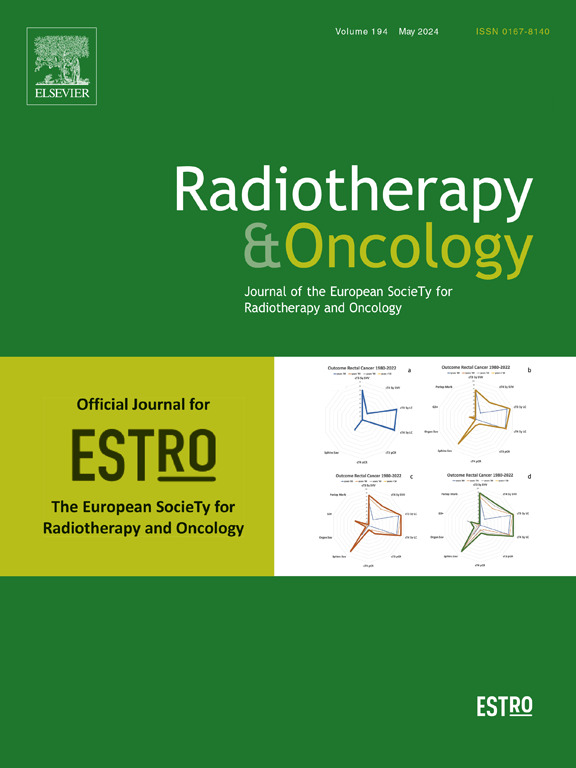结合间接MRI信息的基于ct的前列腺自动分割深度学习模型。
IF 4.9
1区 医学
Q1 ONCOLOGY
引用次数: 0
摘要
背景和目的:计算机断层扫描(CT)成像对前列腺癌外部放射治疗的软组织结构描绘提出了挑战。指南要求输入磁共振成像(MRI)信息。我们开发了一个深度学习(DL)前列腺和高危器官轮廓模型,旨在找到CT成像中的mri真相。材料和方法:该研究利用了165名前列腺癌患者的ct扫描数据,其中136次扫描用于训练,29次用于测试。根据欧洲放射与肿瘤学会(ESTRO)和放射肿瘤学实践咨询委员会(ACROP)轮廓指南,研究重点是轮廓五个感兴趣区域(roi):包括静脉丛(VP) (CTV-iVP)和不包括VP (CTV-eVP)、膀胱、肛肠和整个精囊(SV)的前列腺临床靶体积。人体描绘包括在过程中融合核磁共振成像和计划的ct扫描,但模型本身在其开发过程中从未显示过核磁共振图像。模型训练涉及三维U-Net架构。两名临床医生根据基于时间的标准对模型进行了独立的定性评价,并使用Dice相似系数(DSC)和第95百分位Hausdorff距离(HD95)将DL分割结果与人工适应进行了比较。结果:对CTV-iVP和CTV-eVP的DL分割的定性回顾显示,96% %的病例中有2或3 / 3的病例需要临床医生进行最小的手动调整。DL模型在描述CTV-iVP和CTV-eVP方面表现出相当的定量性能,DSC为89 %,标准差为3.3 %。CTV-iVP的HD95为4 mm, CTV-eVP为4.1 mm,两种轮廓的标准偏差为2.1 mm。肛肠、膀胱和SV分别在定性分析中得分为3分(满分3分),分别为62% %、72% %和55% %。直肠DSC和HD95分别为90 %和5.5 mm,膀胱DSC和HD95分别为96 %和2.9 mm,精囊DSC和HD95分别为81 %和4.6 mm。结论:据我们所知,这是第一个设计用于在CT成像中实现MRI轮廓指南的DL模型,也是第一个根据ESTRO-ACROP轮廓指南训练的模型。这种基于ct的DL模型提供了一个有价值的工具来帮助前列腺描绘,而不需要实际的MRI信息。本文章由计算机程序翻译,如有差异,请以英文原文为准。
Incorporating indirect MRI information in a CT-based deep learning model for prostate auto-segmentation
Background and purpose
Computed tomography (CT) imaging poses challenges for delineation of soft tissue structures for prostate cancer external beam radiotherapy. Guidelines require the input of magnetic resonance imaging (MRI) information. We developed a deep learning (DL) prostate and organ-at-risk contouring model designed to find the MRI-truth in CT imaging.
Material and Methods
The study utilized CT-scan data from 165 prostate cancer patients, with 136 scans for training and 29 for testing. The research focused on contouring five regions of interest (ROIs): clinical target volume of the prostate including the venous plexus (VP) (CTV-iVP) and excluding the VP (CTV-eVP), bladder, anorectum and the whole seminal vesicles (SV) according to The European Society for Radiotherapy and Oncology (ESTRO) and Advisory Committee on Radiation Oncology Practice (ACROP) contouring guidelines. Human delineation included fusion of MRI-imaging with the planning CT-scans in the process, but the model itself has never been shown MRI-images during its development. Model training involved a three-dimensional U-Net architecture. A qualitative review was independently performed by two clinicians scoring the model on time-based criteria and the DL segmentation results were compared to manual adaptations using the Dice similarity coefficient (DSC) and the 95th percentile Hausdorff distance (HD95).
Results
The qualitative review of DL segmentations for CTV-iVP and CTV-eVP showed 2 or 3 out of 3 in 96 % of cases, indicating minimal manual adjustments were needed by clinicians. The DL model demonstrated comparable quantitative performance in delineating CTV-iVP and CTV-eVP with a DSC of 89 % with a standard deviation of 3.3 %. HD95 is 4 mm for CTV-iVP and 4.1 mm CTV-eVP with a standard deviation of 2.1 mm for both contours. Anorectum, bladder and SV scored 3 out of 3 in the qualitative analysis in 62 %, 72 % and 55 % of cases respectively. DSC and HD95 are 90 % and 5.5 mm for anorectum, 96 % and 2.9 mm for bladder, and 81 % and 4.6 mm for the seminal vesicles.
Conclusion
To our knowledge, this is the first DL model designed to implement MRI contouring guidelines in CT imaging and the first model trained according to ESTRO-ACROP contouring guidelines. This CT-based DL model presents a valuable tool for aiding prostate delineation without requiring the actual MRI information.
求助全文
通过发布文献求助,成功后即可免费获取论文全文。
去求助
来源期刊

Radiotherapy and Oncology
医学-核医学
CiteScore
10.30
自引率
10.50%
发文量
2445
审稿时长
45 days
期刊介绍:
Radiotherapy and Oncology publishes papers describing original research as well as review articles. It covers areas of interest relating to radiation oncology. This includes: clinical radiotherapy, combined modality treatment, translational studies, epidemiological outcomes, imaging, dosimetry, and radiation therapy planning, experimental work in radiobiology, chemobiology, hyperthermia and tumour biology, as well as data science in radiation oncology and physics aspects relevant to oncology.Papers on more general aspects of interest to the radiation oncologist including chemotherapy, surgery and immunology are also published.
 求助内容:
求助内容: 应助结果提醒方式:
应助结果提醒方式:


